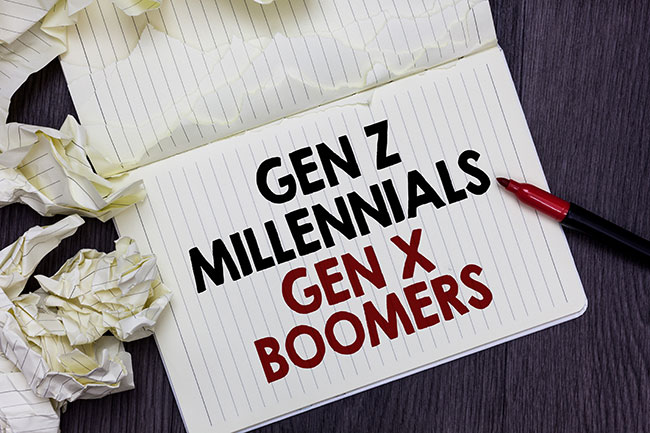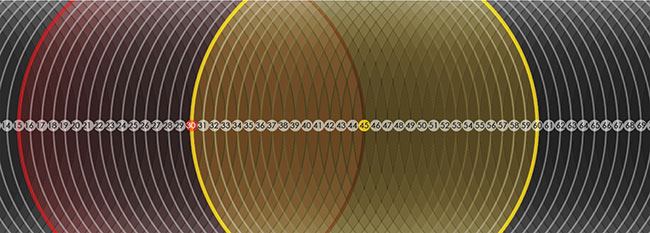Truly just a number
Editor's note: Adam Cook is chief research nerd at research firm Cranium Tap.
 There are a handful of triggers that can achieve a guaranteed eye-roll from yours truly – most of which have nothing to do with marketing or research – but when I hear people talk about Boomers, Gen Xers or Millennials, that’s my involuntary response. While some marketing strategist or guru drones on about targeting one of these “generational segments,” I can almost hear June Carter and Carl Smith’s rendition of “Time’s A Wastin’” playing in the background. It’s a fitting accompaniment when you consider this song was most popular more than 60 years ago – the same bygone era this kind of targeted marketing strategy belongs in.
There are a handful of triggers that can achieve a guaranteed eye-roll from yours truly – most of which have nothing to do with marketing or research – but when I hear people talk about Boomers, Gen Xers or Millennials, that’s my involuntary response. While some marketing strategist or guru drones on about targeting one of these “generational segments,” I can almost hear June Carter and Carl Smith’s rendition of “Time’s A Wastin’” playing in the background. It’s a fitting accompaniment when you consider this song was most popular more than 60 years ago – the same bygone era this kind of targeted marketing strategy belongs in.
Why such marketing blasphemy, you ask? Years of researching, interacting with businesses, reading and simply being able to do some basic mathematics has sobered me up on the reason this form of targeting offers little to no value.
What could possibly diminish such a tried-and-true, much discussed, much deployed, ironclad strategic approach? Five things:
- the origins of generational definitions
- the arbitrary cutoffs in ranges
- the mathematical issue with ranges and aging
- our instinctual preference for simplicity over complexity
- the ways humans relate goes way beyond age
Problem 1: The origins of generational definitions
First, who’s the governing body defining generations? Can’t readily name it, can you? Yeah, there isn’t any. The terms are so much a part of our day-to-day vernacular, we’ve assumed it must have been established by some respected organization. We’ve generally assumed that these generations are groups of people that fall between 15-to-20-year increments in the U.S. Not 15 or 20 years on the dot, just slightly random and arbitrarily defined ranges. It all really started with the Boomers – a surge in U.S. births following World War II. There were so many kids that infrastructure, education and economies had to quickly adapt and accommodate. These were kids being raised in an era of incredible growth following some of the country’s most challenging economies. Media, marketing and consumerism exploded and permeated their entire lifespans.
A better place to start is asking: What is a generation? The definition, based on dictionary.com, is:
“the entire body of individuals born and living at about the same time; the term of years, roughly 30 among human beings, accepted as the average period between the birth of parents and the birth of their offspring; a group of individuals, most of whom are the same approximate age, having similar ideas, problems, attitudes, etc.”
There are seven-plus more definitions but these top three spawn a myriad of problems within themselves.
The third dictionary definition alone presents basic observational issues. Given what we know about Millennials, number three simply negates itself. Millennials are in a hyper-niche, multisegment society that is growing exponentially isolated from “the whole” in terms of “similar ideas, problems, attitudes.” This notion is enough to take down this house of cards but the truth is, technology and the digital age have diminished mass shared experiences for all, not just Millennials. Problem 2 will tackle the leading two definitions.
In the end, there is no singularly recognized governing organization setting clear standards for definition of a generation but we’ve convinced ourselves standards must exist because of the omnipresence of generation-based marketing. A strategy without a solid foundation renders the remaining elements shaky at best.
Problem 2: The arbitrary cutoffs in ranges
When reviewing the second dictionary definition of a generation, note that it indicates a generation is “roughly 30 years.” Whoa, say what? Let’s look at the most common ranges observed for five current generations: Silent/Greatest (17 years), Boomers (18 years), Gen Xers (15 years) and Millennials (18 years). Ever wonder why Generation X was cut to be such a small range? Maybe some marketing nut had a grudge against this age segment at the time and wanted to diminish their perceived value by shrinking its population. Maybe a Millennial wanted to give their generation more attention (these are clearly stereotype-derived generational cheap shots) or maybe a Boomer parent of a Millennial wanted to give their kids more attention by diminishing one segment and expanding their kids’ defined population segment.

The point is, it doesn’t matter. The defined ranges are ultimately arbitrary at best. It’s safe to assume 30 years seemed too sweeping for marketers so, they thought, let’s shrink them. But for some reason, not to a precise range of years. These arbitrary ranges render things even more meaningless.
Why are they like this? No one truly knows. The drawing of arbitrary lines was driven by the second and third dictionary definitions and not the first. As a result, the end of WW II and the Kennedy assassination (or the advent of The Pill as some have suggested) were original driving forces in defining range cutoffs. When you look at the remaining cutoffs for Gen Xers, Millennials and Gen Z, we’re left to wonder: Why these specific years? It’s not quite as clear what historical events should dictate the most recent cutoffs. As a result, it’s safe to assume this is why the definitions of Xers, Millennials and Gen Z remain squishy. It’s possible that what defines a truly shared event during these years started dwindling. After the clearly shared event of the Kennedy assassination, one wonders why events like the moon landing, the Berlin Wall falling, 9/11 or an endless list of other historical events didn’t create new cutoffs.
Getting back to the first dictionary definition (individuals born at the same time), it means that my view of a generation is different from every other individual’s view. The reality is that generational definitions look like a Venn diagram gone crazy (see Figure 1).

The lines are blurred, by 300 million+ in the U.S. alone. There technically shouldn’t be any cutoff dates. John, born of December 31, 1979, and his wife Jane, born on January 1, 1980, don’t see themselves as different generations. This much is obvious, right? Even better, like a colleague of mine once said, “This generational stuff is BS. How is it that I’m in the same generation as my twin sons, born 17 years later? What a crock.”
More simply put, if each of us has a 15-year generational definition on the older and younger sides of the spectrum, that means we each have our own defined generation and share millions of generational inclusions with other people’s definitions – although I would argue the conscious generational radius starts incredibly small from birth and grows throughout one’s lifespan. I’ll reserve diving deeper into this concept for another article.

See Figure 2 for an example of personally defined generations through the lens of a 30-year-old and a 45-year-old. Note the significant overlap in shared generations between two individuals that could be traditionally defined as being in separate generations.
Ultimately, generational definitions are personally defined, not arbitrarily assigned by any governing organization, institution, marketing firm, ad agency, polling group or marketing guru.
Problem 3: The mathematical issue with ranges and aging
Because the first two problems weren’t enough, I can mathematically demonstrate the problems with generational definitions by looking through the lens of age. Not a lot of thought was given to the idea of ranges in the marketing sphere, whether it be anywhere from 15 to 30 years, because if the ranges look nearly equal then one tends to think things are comparatively similar. One problem is your current age defines the size and scope of your shared experiences at any given point in time. For example, it’s safe to say a 70-year-old and a 78-year-old could talk about similar experiences in their lives and would consider on another as peers. Can we say the same of a 5-year-old and a 13-year-old? They’re separated by the same eight-year span. I think we can all agree that a 5-year-old and a 13-year-old will not consider one another as peers that can relate to similar experiences.
The great thing about comparative analysis is we can set equivalents for different age ranges. For example, the 78-year-old is 11.43% older than the 70-year-old and the 13-year-old is 160% older than the 5-year-old. If we want a realistic age comparison with the 5-year-old in a relation that’s similar to the 70- and 78-year-old, we can conclude that a child who’s five years and seven months old is the peer equivalent (the older of each set being 11.43% older than the other). Likewise, a 13-year-old and a child who’s 11 years and eight months old would be equivalent to the 78- and 70-year-old. These examples seem more realistic in peer definition ranges versus the years separating them. You can see how this mathematical realization is evident when using one of the traditionally defined ranges of the different generations with the current year’s age at the bottom and top of each range (see chart).
When you look at the full range of ages from 1 to 100, you can see, yes, each is separated by one year but the percent difference in age more accurately represents the difference in relatability between humans spanning the entire spectrum. A 2-year-old is 100% older than a 1-year-old and there are clear differences in their human behavioral needs and capabilities; whereas there’s only a 1.01% difference between a 100-year-old and 99-year-old. I think most of us would agree that their differences in human behavioral needs or capability differences are minimal.
This model indicates that the older we get, the wider range of ages we can relate to. The percentage gap shrinks or the rate at which we age slows down. I know, it’s a bit of a mind-blowing concept but it explains why my 6-year-old daughter thinks a two-hour movie is forever and my 75-year-old mom can’t believe how fast the last year went by. Time is in context of the life you’ve lived to that point.
Age presents differences along the social, physical and cognitive development spectrums as well. The younger you are the more changes you go through. Under one of the current definitions of Millennials they are between the ages of 18 and 34. An 18-year-old “young adult” is only two years removed from earning a driver’s license and preparing to graduate from high school, while a 34-year-old adult could be on his/her third career change, married or divorced and have a second child on the way. Please stop with these groupings. Do these sound like two adults that can relate to each other?
Empirically, the mathematics of aging itself present the strongest case against designating generations based on arbitrary birth-year ranges.
Problem 4: Our instinctual preference for simplicity over complexity
Given the flimsy nature of arbitrarily defined segments and the obvious issues they present, we have to ask ourselves why there’s such an obsession with them in marketing. The business world is full of flavor-of-the-month strategies and buzzwords. Why has this one hung around for so long?
Here’s my hypothesis:
The power of branding is unfortunately stronger than we would like to believe. Simple phrases and concepts grab hold of us like parasites and are nearly impossible to notice, let alone shed. Give it a label and it will hang around our necks like an albatross. Humans gravitate toward concepts that are easy to remember and concepts that can be easily shared.
When you strip away the branding element of “generational targeting,” what do we have? It’s simply “age-range targeting.” When you call it what it is, the veneer starts to dull rather quickly. Worse, this “strategic, targeted” approach only allows you to use five different age ranges – one on the way out (the Silent generation) the other still emerging (Gen Z) so, really there’s only three. It’s safe to say this is anything but targeted.
These limited segments sure sound simple and are easy to wrap my head around, whereas, having hundreds, if not thousands, of different behavioral or usage-based targets sounds daunting. Who can blame a stressed-out marketer for wanting a simpler way? But the strategic reality is, if this conventional “generational targeting” is your approach, you’re barely walking upright on the evolutionary chart of marketing.
Over time, contributors from the media, marketing and advertising industries came up with these arbitrary generational labels, successfully funneling a lot of attention and money their way. The realities are that marketing has become increasingly more complex and business decision-makers are still searching for simple constructs that hearken back to decades-old, sweeping approaches to targeting. Voila! The birth of Millennials and generational targeting.
The advent of technology and a digital society hasn’t only impacted the youngest of our society, it’s helped erode what flimsy walls may have already existed between varying age segments. Now, a 55-year-old Marvel comic book fan can share the same experiences as a 15-year-old one, buy the same stuff, attend the same Comic-Con events and share common ground. (Insert sounds of traditional and stereotypical age-devised walls collapsing here.)
Don’t forget: Our desire for simple and catchy marketing solutions has clouded our judgment and decisions in employing and executing effective marketing strategies.
Problem 5: The ways humans relate goes way beyond age
Lastly, the complexities of geographic, family, social, economic, racial, cultural, values and a myriad of other circumstances can have further implications on shared life experiences. I’m only two years older than my wife (who can be labeled Millennial or Xer depending on which definition you use) and I, a traditionally categorized Xer, periodically reference childhood memories of MTV music videos and various TV shows. She regularly reminds me that she has no idea what I’m talking about. You’d think I was talking to someone 15 years older than me. She grew up in a small southwestern Virginia town and had no cable television. Maybe only two or three local broadcast stations were all that really came in on their television.
All these factors come into play on shared experiences but are not accounted for when creating generational or age-range targeting segments.
Trendy marketing concept wildfire
The truth is, at one point I considered writing a book called “Micro-Generations; the Targeted Approach that Will Forever Change Marketing.” In the first half of this book I would outline the clear issues with generational targeting as it’s defined now (similarly to this article but with greater detail, research and charts to validate the premise even further). In the second half, I would offer newly minted generations defined by individual years. I would outline stereotype-derived descriptions for each of the 100 different and newly defined generations, with the best proof of concept being each reader’s response to their own. That moment where the reader thinks, “This describes my micro-generation to a T,” would help to validate the concept and springboard it into trendy marketing concept wildfire. “You’ve got to read this book!” people would say in every marketing meeting for the next 18 months. It would reach multiple top business book bestseller lists. I would get invites to talk shows and podcasts. I’d introduce tests for identifying which micro-generation you are most likely to resemble based on attitudes and behaviors other than your predetermined age. I’d have a business training seminar machine making loads of money. I’d develop the concept for different countries, making it an international hit. My house, kids’ educations and retirement would all be paid for.
And I’d be a fraud – no different than the frauds peddling the current generational targeting approach.
I’d be preying on the business leaders around the world obsessed with generational targeting, seemingly unaware of the inherent confirmation biases it presents and how it’s nonsensically guiding their marketing decisions.
Know your customers
So, what’s a generational marketer to do given the underwhelming evidence of this approach’s value? Get to know your customers. Get to know how your customers differ from your industry’s customers. Get to know how your customers and your industry’s customers differ from the markets you serve. And I don’t mean get to know them simply by age or traditional demographic breakdowns. Learn about their lives, their activities, their interests, their spending habits, technology behaviors and more. These details will immeasurably impact the way you go to market and target the greatest opportunities.
If I’ve been able to kick your generational-targeted marketing crutch in the least bit, let me be the first to welcome you to the only generation that truly exists, where sweeping stereotypes no longer apply: It’s called Your Generation.
Now go, spread the word about how we’re being fooled and help others wean themselves off this wretched fixation. It’s time to bury this way of thinking for good and start employing more evolved approaches. Best of luck!
